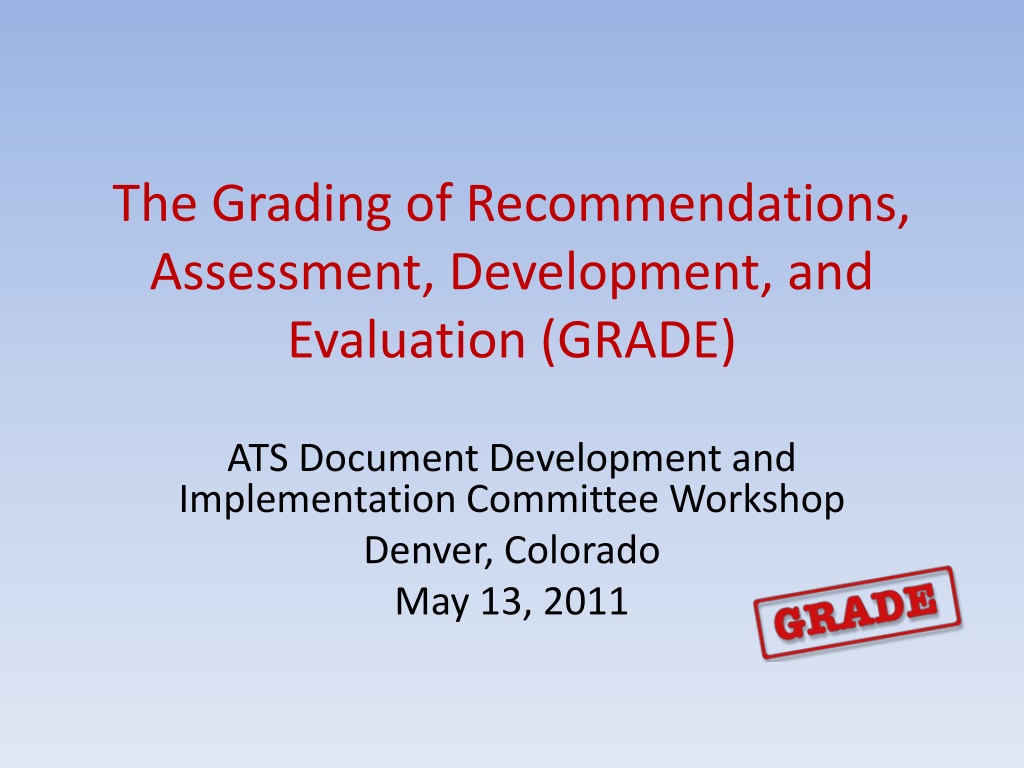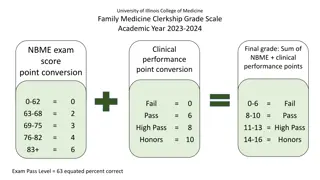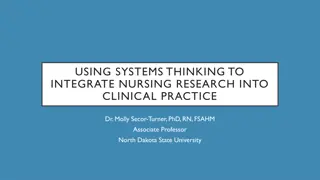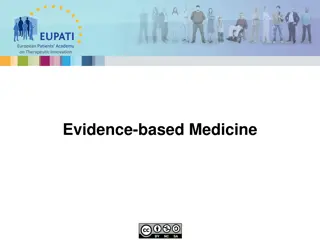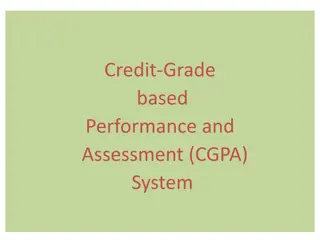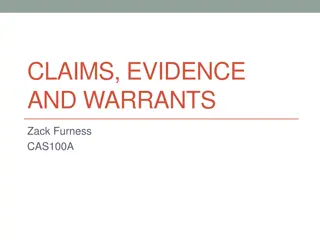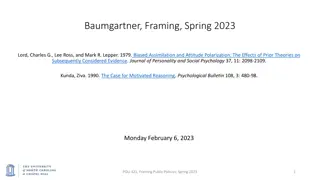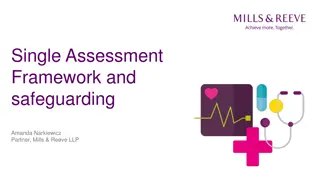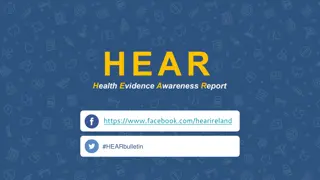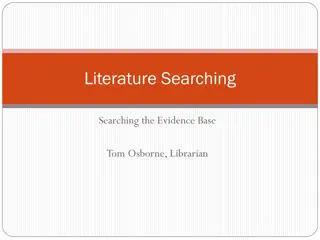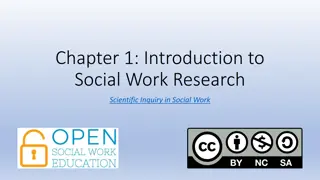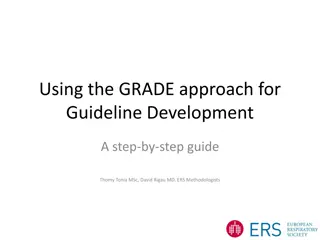Understanding the GRADE Approach in Evidence-Based Practice
Exploring the GRADE approach for evidence evaluation involves formulating questions, determining outcomes, conducting literature reviews, estimating intervention effects, and grading recommendations based on evidence quality. Step by step guidance is provided, including using the PICO format for question formulation and prioritizing patient-important outcomes.
Download Presentation

Please find below an Image/Link to download the presentation.
The content on the website is provided AS IS for your information and personal use only. It may not be sold, licensed, or shared on other websites without obtaining consent from the author. Download presentation by click this link. If you encounter any issues during the download, it is possible that the publisher has removed the file from their server.
E N D
Presentation Transcript
The Grading of Recommendations, Assessment, Development, and Evaluation (GRADE) ATS Document Development and Implementation Committee Workshop Denver, Colorado May 13, 2011
The GRADE approach 1. Formulate your question. 2. Determine the outcomes of interest. 3. Conduct a systematic review of the literature. 4. Choose your threshold magnitude of effect. 5. Estimate the effect of the intervention. 6. Appraise the quality of evidence. 7. Formulate the recommendation. 8. Determine the strength of the recommendation. 9. Grade the recommendation.
Step 1: Formulate your question Begin by formulating your question using the PICO format: P: Population I: Intervention C: Comparator O: Outcomes
Step 1: Formulate your question Examples: Should patients with COPD and an FEV1 of 50 to 80% be referred for pulmonary rehabilitation? Should patients with group 1 PAH and a WHO functional classification of III be treated with a prostanoid or an endothelin receptor antagonist?
Step 1: Formulate your question Michael Gould is conducting a separate session about formulating clinical questions using PICO, if you desire additional details about this step.
Step 2: Determine the outcomes Brainstorm and list all patient-important outcomes. Mortality, length of stay, and dyspnea are patient- important outcomes. In contrast, FEV1 and oxygenation are not patient- important outcomes.
Step 2: Determine the outcomes Prioritize the outcomes as critical, important, or informative. 9 8 7 critical 6 5 important, but not critical 4 3 2 informative, but not important 1
Step 2: Determine the outcomes This should be done carefully because the quality of evidence that you will eventually assign to the recommendation is the lowest quality of evidence among the critical outcomes.
Step 2: Determine the outcomes Examples: Outcome Priority Quality of Evidence Mortality Critical High Frequency of hospitalization Very important Moderate Dyspnea Very important Moderate The overall quality of evidence is high. Outcome Priority Quality of Evidence Mortality Critical High Frequency of hospitalization Critical Moderate Dyspnea Very important Moderate The overall quality of evidence is moderate.
Step 3: Conduct a systematic review A systematic review should be conducted to identify the evidence related to the population, intervention, comparator, and outcomes that you identified in steps 1 and 2. This is the most time-consuming step in the application of GRADE.
Step 3: Conduct a systematic review Jan Brozek is conducting a separate session about performing a systematic review, if you desire additional details about this step.
The following steps must be performed for each outcome.
Step 4: Choose a threshold magnitude of effect Decide upon the magnitude of effect that warrants a change in clinical practice. This will depend upon the importance of the desirable effects of the intervention and the seriousness of the potential undesirable effects.
Step 4: Choose a threshold magnitude of effect A large magnitude of effect should be chosen if the benefits are minor, the potential harms are serious, or the cost is high. In contrast, a smaller magnitude of effect may be chosen if the benefits are important, the potential harms are minor, or the cost is low.
Step 4: Choose a threshold magnitude of effect Examples: A small magnitude of effect is sufficient to recommend aspirin during an acute MI, since decreased mortality is important, serious harms are rare, and the cost is low. A large magnitude of effect would be necessary to recommend thrombolysis for DVT because the benefit (decreased chronic venous stasis) is minor and the harms (intracranial hemorrhage) are serious.
Step 5: Estimate the effect of the intervention If the systematic review included a meta- analysis, then the result of the meta-analysis gives the estimated effect. If the systematic review did not include a meta-analysis, then individual studies are needed to inform judgments about the estimated effect.
Step 5: Estimate the effect of the intervention The estimated effect of inhaled short-acting beta- agonists is MD -24.70 (95% CI -28.67 20.74).
Step 6: Assess the quality of evidence The quality of evidence is the confidence that you have that the direction and the magnitude of the estimated effect are correct. Quality of evidence Suggested implications High further research is unlikely to change the confidence in an estimated effect; we are confident that we can expect very similar effect in a population for which the recommendation is intended Moderate further research is likely to have an important impact on the confidence in an estimated effect and may change that estimate Low further research is very likely to have an important impact on the confidence in an estimated effect and is likely to change that estimate Very low any estimate of an effect is very uncertain
Step 6: Assess the quality of evidence Make a baseline assumption: Randomized trials = high quality evidence. Observational studies (i.e., case-control studies and controlled prospective or retrospective cohort studies) = low quality evidence. Unsystematic observations (i.e., case series, case reports, clinical experience) = very low quality evidence.
Step 6: Assess the quality of evidence Look for reasons to downgrade the quality of evidence (i.e., factors that lower your confidence in the estimated effect): Risk of bias Inconsistency Indirectness Imprecision Reporting bias
Step 6: Assess the quality of evidence Risk of bias: Concealment Patient blinded Caregiver blinded Assessor blinded Objective outcome Loss to follow-up Stopped early for benefit -- Intention to treat -- Baseline differences -- Selection bias -- Statistical analysis
Step 6: Assess the quality of evidence Inconsistency: Inconsistency exists when there is substantial variation in the direction or size of the effect across studies. I2 test. P-value of heterogeneity. Eye ball test.
Step 6: Assess the quality of evidence Indirectness: Indirectness exists when the population, intervention, comparator, or outcome of the clinical question differ from that in the studies. Examples: Population: Your question is related to pneumococcal vaccination in the elderly, but the relevant studies were conducted in adults of all ages.
Step 6: Assess the quality of evidence Intervention: Your question is related to the use of static resistance training for pulmonary rehabilitation in patients with COPD, but the relevant studies looked at dynamic resistance training. Comparator: Your question is related to chlorhexidine versus oral digestive decontamination, but the relevant studies compared chlorhexidine to placebo and oral digestive decontamination to placebo.
Step 6: Assess the quality of evidence Outcomes: Your question is related to the effect of leukotriene receptor antagonists on exercise capacity in patients with exercise-induced bronchoconstriction, but all of the studies measured the impact of leukotriene receptor antagonists on FEV1.
Step 6: Assess the quality of evidence Imprecision: Imprecision exists if the ends of the confidence interval lead to different clinical conclusions. In other words, the trial was too small to definitively answer the clinical question.
Step 6: Assess the quality of evidence RR 0.70, 95% CI 0.50-0.90 RR 0.70, 95% CI 0.30-1.10 RR 0.70, 95% CI 0.43-0.97 Benefit No effect Harm
Step 6: Assess the quality of evidence Reporting bias: Reporting bias is the preferential reporting, publishing, and dissemination of data that is statistically significant, shows a large effect, and/or demonstrates a benefit. Reporting bias is notoriously difficult to detect. There are three variations of reporting bias: Publication bias Selective outcome reporting bias Lag bias
Step 6: Assess the quality of evidence Publication bias exists if a study is never reported or published.
Step 6: Assess the quality of evidence Publication bias exists if a study is never reported or published. The results of Study 15 were never published or shared with doctors, even as less rigorous studies that came up with positive results for Seroquel were published and used in marketing campaigns aimed at physicians and in television ads aimed at consumers.
Step 6: Assess the quality of evidence Selective outcome reporting bias exists if favorable outcomes are reported, while unfavorable outcomes are not.
Step 6: Assess the quality of evidence Selective outcome reporting bias exists if favorable outcomes are reported, while unfavorable outcomes are not.
Step 6: Assess the quality of evidence Lag bias exists if the reporting or publishing of negative trials is delayed. Ioannidis JP. JAMA 1998; 279(4):281. N=109 clinical trials Median duration from trial completion to publication Negative trials 3.0 years Positive trials 1.7 years Hopewell S, et al. Cochrane Database Syst Rev 2003; 4:MR000011. N=196 clinical trials Median duration from trial initiation to publication Negative trials 6 to 8 years Positive trials 4 to 5 years
Step 6: Assess the quality of evidence The net result of publishing positive and not negative studies is that the body of evidence then exaggerates the effect of the intervention. The evidence may suggest that an intervention has an effect even if the truth is no effect, or may indicate that an intervention has a large effect even if the truth is a small effect. Generally speaking, you should be concerned about reporting bias if the body evidence consists of many small trials showing a large benefit, especially if the trials were industry funded.
Step 6: Assess the quality of evidence Look for reasons to upgrade the quality of evidence (i.e., factors that increase your confidence in the estimated effect): Large effect Dose-response effect Reverse confounding
Step 6: Assess the quality of evidence Large effect: The effect size is determined by looking at the relative effect, rather than the absolute effect. An effect is considered large if the RR is 2 but less than 5, or if the RR is 0.5 but >0.2 > upgrade one level. An effect is considered very large if the RR is 5 or <0.2 > upgrade two levels.
Step 6: Assess the quality of evidence Dose-response effect: A dose-response effect is present if a more intense intervention (i.e., larger dose, longer duration) leads to a larger effect over varying levels of the intervention.
Step 6: Assess the quality of evidence Reverse confounding: Called various things because there is no good descriptive term. Exists if: All conceivable confounders would underestimate the effect, but the study found an effect. All conceivable confounders would overestimate the effect, but the study found no effect.
Step 6: Assess the quality of evidence Make a baseline assumption based upon the study design. Look for reasons to downgrade or upgrade the quality of evidence: Downgrade Upgrade Risk of bias -- Large effect Inconsistency -- Dose-response gradient Indirectness -- Reverse confounding Imprecision Reporting bias
Table E7. Evidence table for the use of hydroxyurea in patients with sickle cell disease who have three or more painful vasoocclusive crises per year, or at least one episode of acute chest syndrome. Author(s): Wilson, Kevin C. Date: 2010-12-10 Question: Should hydroxyurea be used in patients with sickle cell disease who have more than three vasoocclusive crises per year, or at least one episode of acute chest syndrome? Bibliography: Charache S, Terrin M, Moore RD. N Engl J Med 1995; 332:1317-1322; Ferster A, Vermylen C, Cornu G, et al. Blood 1996; 88:1960; Steinberg MH, Barton F, Castro O, et al. JAMA 2003; 289:1645-1651; and Steinberg MH, McCarthy WF, Castro O. et cal. Am J Hematol 2010; 85:403. Summary of findings Quality assessment No of patients Effect Importance Quality No of studies Other Relative (95% CI) Design Limitations Inconsistency Indirectness Imprecision Hydroxyurea control Absolute considerations Long-term mortality serious2 1 randomised trials1 no serious limitations no serious inconsistency no serious indirectness dose response gradient3 HIGH 81/147 (55.1%) RR 0.84 (0.65 to 1.09) 9 fewer per 100 (from 19 fewer to 5 more) 60/152 (39.5%) CRITICAL Hospitalizations 1 randomised trials4 no serious limitations no serious inconsistency no serious indirectness no serious imprecision strong association5 HIGH 19/22 (86.4%) RR 0.32 (0.16 59 fewer per 100 (from 31 fewer to 73 fewer) 6/22 (27.3%) IMPORTANT to 0.64) Frequency of acute chest syndrome serious7 1 randomised trials6 no serious inconsistency no serious indirectness no serious imprecision strong association8 HIGH 51/147 (34.7%) RR 0.47 (0.31 to 0.72) 18 fewer per 100 (from 10 fewer to 24 fewer) 25/152 (16.4%) IMPORTANT Frequency of sickle cell crises serious7 MODERATE IMPORTANT 1 randomised trials6 no serious inconsistency no serious indirectness no serious imprecision none Median 2.5 crises per year Median 4.5 crises per year Not estimable Not estimable
Step 7: Formulate the recommendation The decision to recommend an intervention (or recommend against an intervention) should take into account the following: The balance of desirable and undesirable effects. The quality of evidence. Patient values and preferences. Burden, resource utilization, cost, and feasibility.
Step 7: Formulate the recommendation The recommendation should be written using the PICO format: For patients with exercise-induced asthma, we recommend/suggest an inhaled short-acting bronchodilator administered 15 minutes prior to exercise. For patients with sickle cell disease-related pulmonary hypertension, we recommend/suggest hydroxyurea therapy.
